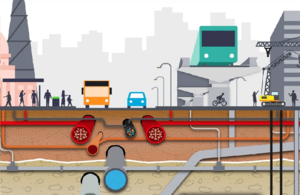Why nuclear power?
In light of high global gas prices, we need to ensure Britain’s future energy supply is bolstered by reliable, affordable, low carbon power that is generated in this country.
New nuclear is not only an important part of our plans to ensure greater energy independence, but to create high-quality jobs and drive economic growth.
Large-scale nuclear is a very low-carbon technology, which provides the reliable baseload power we need at scale from a very small land area; Hinkley Point C, for example, will power around 6 million homes from a just a quarter of a square mile.
Is nuclear power safe?
Yes. As confirmed by the UN’s International Atomic Energy Agency, nuclear power plants ‘are among the safest and most secure facilities in the world,’ and nuclear power is one of the safest forms of energy generation.
For context, the annual radiation dose to an adult living beside a new nuclear plant is much less than taking one trans-Atlantic flight or eating 100g of Brazil nuts – neither of which have heavy radiation.
In the UK, we have a well-respected regulatory system which reflects international best practice, and an industry which places an extremely high value on safety, achieving world-leading health and safety standards every time it is examined.
Nuclear power has operated in the UK for decades without incident, and all UK nuclear operators are answerable to robust and independent regulators – the Office for Nuclear Regulation (ONR) and the appropriate environmental regulator. If the ONR judged that any nuclear installation was not safe or secure it would not be allowed to operate.
How does nuclear power work?
Traditional nuclear power plants use heat produced during nuclear fission to produce steam. The steam is used to spin large turbines that generate electricity. Nuclear power plants heat water.
In nuclear fission, atoms are split apart to form smaller atoms, releasing energy. Fission takes place inside the reactor of a nuclear power plant. At the centre of the reactor is the core, which contains uranium fuel split into ceramic pellets.
Each ceramic pellet produces about the same amount of energy as 150 gallons of oil. These energy-rich pellets are stacked end-to-end in 12-foot metal fuel rods. A bundle of fuel rods, some with hundreds of rods, is called a fuel assembly. A reactor core contains many fuel assemblies.
Both the Committee on Climate Change and the International Energy Agency have highlighted the role for new nuclear electricity generating capacity, in partnership with renewables, as a key element of achieving net zero. A recent report by the UN Economic Commission for Europe was clear that “the world’s climate objectives will not be met if nuclear technologies are excluded” from future decarbonisation.
What about nuclear waste disposal?
The government is committed to using Geological Disposal Facilities (GDF) to dispose of nuclear waste.
GDF is internationally recognised as the best long-term solution for dealing with radioactive waste.
We need a sustainable solution for the radioactive waste that has already accumulated over many decades. It’s currently stored safely in facilities around the UK, but this isn’t a long term solution and we will be moving towards geological disposal for new and existing waste.
A programme of local engagement events is planned from 4th March for local people to find out more about a GDF and what it would mean for the community that hosts it.
A GDF is a multi-billion-pound infrastructure investment and will provide skilled jobs and benefits to the community that hosts it for more than 100 years. It is also likely to involve major investments in local transport facilities and other infrastructure.
What is the government currently doing to support nuclear power?
The strategy will see a significant acceleration of nuclear, with an ambition of up to 24GW by 2050 to come from this safe, clean, and reliable source of power. This would represent up to around 25% of our projected electricity demand. Subject to technology readiness from industry, Small Modular Reactors will form a key part of the nuclear project pipeline.
A new government body, Great British Nuclear, will be set up immediately to bring forward new projects, backed by substantial funding, and we will launch the £120 million Future Nuclear Enabling Fund this month. We will work to progress a series of projects as soon as possible this decade, including Wylfa site in Anglesey. This could mean delivering up to 8 reactors, equivalent to one reactor a year instead of one a decade, accelerating nuclear in Britain.
We are committed to building the first new nuclear power station in a generation at Hinkley Point C in Somerset, which will provide 3.2 GW of secure, low carbon electricity for around 60 years to power around 6 million homes and provide 25,000 job opportunities.
EDF are the lead investor building Hinkley Point C. They are targeting the first reactor coming online in June 2026. The developer is fully funding the project.
We have been in constructive negotiations on the Sizewell C project in Suffolk since January 2021, as the most advanced potential project in the UK. If approved Sizewell C would be a replica of Hinkley Point C, providing electricity for 6 million homes, and creating thousands of high value jobs nationwide.
In January we provided £100 million of funding for the Sizewell C developer to invest in the project to help bring it to maturity, attract investors, and advance to the next phase in negotiations.
As set out in the 2021 Spending Review, up to £1.7 billion of funding is available to support approval of at least one new nuclear power plant this Parliament.
The Nuclear Energy (Financing) Act received Royal Assent last week. The Act will enable use of the Regulated Asset Base funding model for new nuclear projects, which will unblock obstacles to developing these projects and cut the cost of financing them.
The Advanced Nuclear Fund includes up to £210 million announced in November 2021 for Rolls-Royce to develop the design for one of the world’s first Small Modular Reactors. This could be deployed in the UK in the early 2030s to turbocharge UK nuclear capacity.
We are also establishing a new Future Nuclear Enabling Fund of up to £120 million to provide targeted support for new nuclear and make it easier for new companies to enter the market.
What are Small Modular Reactors (SMRs)?
Small Modular Reactors are smaller versions of conventional water-cooled nuclear reactors. Designs come in different sizes but have power output roughly a fifth to a third of the larger and more traditional reactors at Hinkley Point C.
There are a wide range of new reactor technologies under development around the world. Many designs have the potential for a range of applications beyond low-carbon electricity generation, including production of hydrogen, direct heat for industrial or domestic use or nuclear waste management.
The UK government believes that SMRs could play an important role alongside large nuclear as a low-carbon energy source to support a secure, affordable decarbonised energy system. They can be easily manufactured away from the sites where they are used and deployed where needed and could be a transformative technology for the UK’s industrial heartlands.
What are Advanced Modular Reactors (AMRs)?
AMRs are the next generation of nuclear power. These reactors use novel and innovative fuels, coolants, and technologies to generate extreme heat for industrial applications as well as for electricity to power people’s homes.
They take advantage of the same modular-building principles as SMRs, making them more flexible to deploy.
We have committed up to £385 million in the Advanced Nuclear Fund (ANF) to support SMRs and AMR development. This includes up to £210 million awarded as a grant to Rolls-Royce SMR to develop their SMR design, which will be matched by industry.
This fund will be part of the measures the government will take to inform investment decisions during the next Parliament on further nuclear projects.
The ANF also includes funding for progressing plans for an ambitious Advanced Modular Research, Development & Demonstration (RD&D) programme which aims to enable an AMR demonstration by the early 2030s, at the latest. We recently announced that High Temperature Gas Reactors (HTGRs) will be the technology focus for this programme.
How long does it take for a nuclear plant to come online?
The timeframe for new nuclear projects coming online varies considerably depending on a range of factors.
Large-scale nuclear projects do have long-construction periods, but Small Modular Reactors for example could be deployable during the early 2030s, with innovation in manufacturing and construction having the potential to bring down build time further.
What’s happening to the older nuclear power stations?
EDF, which operates all of the UK’s Advanced Gas-cooled Reactors (AGRs) as well as Sizewell B, have extended the lifetime of many of the power stations built in the 1970s and ‘80s in the UK.
However, when nuclear stations reach the end of their generating capability, they move into the next phase of their lives which is to remove the fuel and to prepare for decommissioning.
This process is handled by the Nuclear Decommissioning Authority (NDA), a government agency with high-level technical expertise in handling this process in a safe and secure manner.
There are currently 6 generating stations across England and Scotland operated by EDF Energy. Sizewell B, the UK’s only Pressurised Water Reactor, is expected to continue generation past 2028.
The AGR stations at Torness, Hinkley Point B, Heysham 1, Heysham 2 and Hartlepool will end generation between 2022 and 2028.
Two other AGR stations, Dungeness B and Hunterston B, recently ended generation to move into the final defueling phase and then decommissioning.
In terms of future use for these sites, the NDA have a clear mission to safely decommission them, freeing up land for future uses.
The NDA welcomes engagement from all stakeholders with a potential future use of land and have a history of engagement and land transfer across their portfolio.

